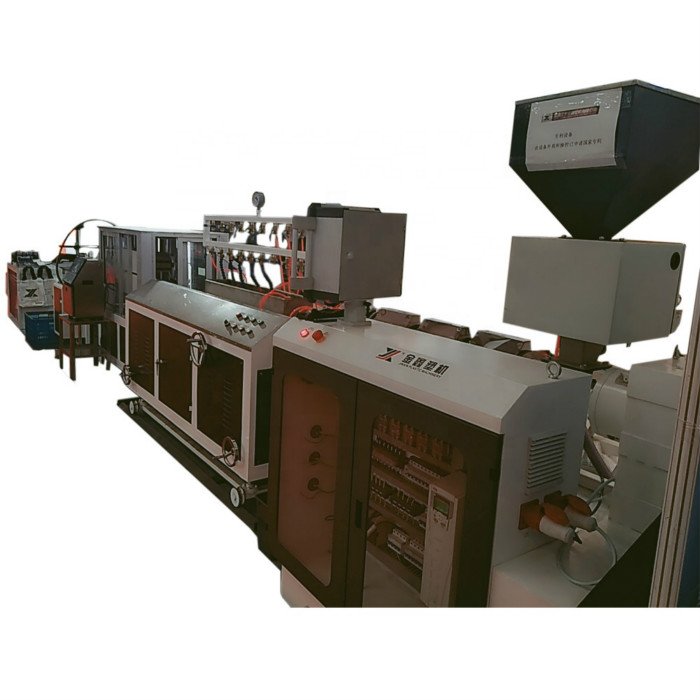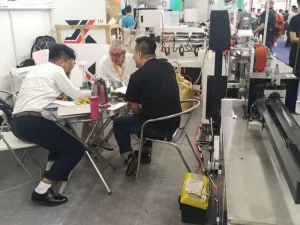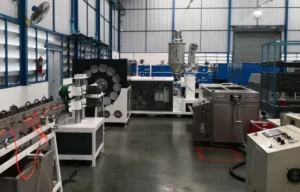Demystifying the Extrusion Line in Plastic Manufacturing
Within the expansive realm of plastic manufacturing, the phrase ‘extrusion line’ signifies a sequential arrangement of industrial machinery and accompanying equipment. This setup is vital in maintaining an uninterrupted production flow of plastic goods, ranging from the most straightforward plastic sheets to the more intricate profiles. The purpose of this article is to illuminate the complexities of an extrusion line, providing a thorough understanding of its various components and operations for the reader. We will delve into the range of machines involved in the process, detailing their individual roles and the interplay between them. Additionally, we will discuss the specific prerequisites and conditions that vary according to the different types of plastic products being manufactured, thereby providing a comprehensive overview of the extrusion line’s role in the plastic industry.
Understanding an Extrusion Line
An extrusion line comprises a series of sequentially arranged machines, each designed to perform a specific task, working in unison to transform raw plastic materials into a variety of finished products.
This complex process is much more than just the simple melting and shaping of plastic. It involves an intricate series of steps, each of which is handled by a specialized piece of machinery, expertly designed for that specific task. The raw material is meticulously processed through each machine in the line, gradually taking shape as it passes from one stage to the next.
The unique configuration of an extrusion line can vary significantly depending on the specific type of product being manufactured. This could range from flat, thin sheets to round pipes, or even complex profiles, each requiring a different set of machines and processes in the extrusion line. This adaptability allows for a wide array of plastic products to be manufactured, meeting a variety of needs and applications in various industries.

Key Components of an Extrusion Line
- Hopper: Acting as the initial storage area, the hopper is where raw plastic material, typically in the form of small, compact pellets or granules, is stored. The Hooper now offers drying of raw materials as well. This is the place from where the material is methodically fed into the extruder.
- Extruder: Often considered the heart and soul of the line, the extruder is the point at which the plastic material undergoes a transformative process. Here, the stored plastic is subjected to heat until it melts, and then it is subsequently pushed through a specialized device known as a die, which allows it to take on a continuous, uniform shape.
- Die: This is a highly specialized tool, carefully engineered to shape the molten, liquefied plastic into the desired profile. The die plays a crucial role in determining the final shape and form of the plastic product.
- Cooling and Sizing Equipment: Once the plastic has been extruded, it immediately undergoes cooling. This is usually done in a water bath or by air, depending on the specific requirements of the product. Following the cooling process, the product is then sized to the correct dimensions, ensuring consistency in the final product.
- Take-off Equipment: This category includes a variety of machinery such as rollers or conveyors. Their primary function is to pull the newly formed, extruded product away from the die, thus allowing for continuous production.
- Cutting or Winding Equipment: The final step in the process varies depending on the specific product being created. The extruded plastic may be cut to a specified length if the product requires it. Alternatively, if the product is to be stored or transported, it may be wound onto rolls for convenience and efficiency.
Extrusion Lines for Different Products
- Sheet Extrusion: Involves flat dies and a series of rollers to cool and flatten the plastic into sheets. Commonly used for making plastic films or plates.
- Pipe and Tubing Extrusion: Utilizes cylindrical dies and often includes vacuum sizing equipment to ensure precise diameters and wall thicknesses.
- Profile Extrusion: Used for complex shapes (like window frames) and often involves intricate dies and specialized cooling systems to maintain shape integrity.
Specialized Equipment for Specific Materials
Some plastics require additional processing steps or specialized equipment. For instance:
- Highly Moisture-Sensitive Materials: Certain materials, such as PET (Polyethylene Terephthalate) or nylon, are highly sensitive to moisture. These materials may need to undergo a pre-drying process before they are subjected to extrusion. This is to prevent any potential quality issues that could compromise the integrity of the final product.
- High-Temperature Polymers: Some materials are extruded at high temperatures. These materials might necessitate the use of specialized screws and barrels that are resistant to wear and corrosion. This is to ensure that the equipment can withstand the high temperatures without degrading over time.
- Filled or Reinforced Plastics: When incorporating fillers or reinforcements into plastic, additional mixing and compounding equipment may be needed. This is to ensure the uniform distribution of the fillers or reinforcements throughout the plastic, which is crucial for maintaining the properties of the final product.
- Co-Extrusion: The process of producing multi-layered products involves the use of multiple extruders. These extruders feed different materials into a single die, allowing for the creation of complex, multi-layered products.

The Importance of Auxiliary Equipment
In addition to the main components, auxiliary equipment plays a critical role in the efficiency and quality of the extrusion process. This includes material handling systems, mixers for blending materials, and devices for applying coatings or treatments to the finished product. An example is the production of smooth silver powder shower tubes. A silver colored layer needs to be added to the outer layer of the tubing.

Please refer to our smooth shower hose extrusion line product information:
https://jfextruder.com/extrusion-line/reinforced-hose/smooth-shower-hose/
Conclusion
In the field of plastic manufacturing, an extrusion line represents a complex and intricate assembly of various machines. Each machine within this assembly has a unique and vital role. The primary function of these machines is to effectively transform raw materials into a finished product, a process that requires precision and expertise. The specific configuration of an extrusion line can vary greatly, largely dependent on factors such as the product type being manufactured and the inherent characteristics of the materials being used. For anyone who is directly involved or even tangentially related to the plastics industry, gaining a comprehensive understanding of these nuances is absolutely crucial.
This understanding not only influences the design of the product but also plays a significant role in other crucial decisions. These decisions can range from the selection of suitable materials to the optimization of the process used in the manufacturing. All of these factors intertwine to form the intricate world of plastic manufacturing and its extrusion line.
Tags:
Extrusion Process (2) PA Extrusion (1) Plastic Extruders (4) Reinforced Hose (2) Success Projects (1) TPE Extrusion (1) Troubleshooting (1)

